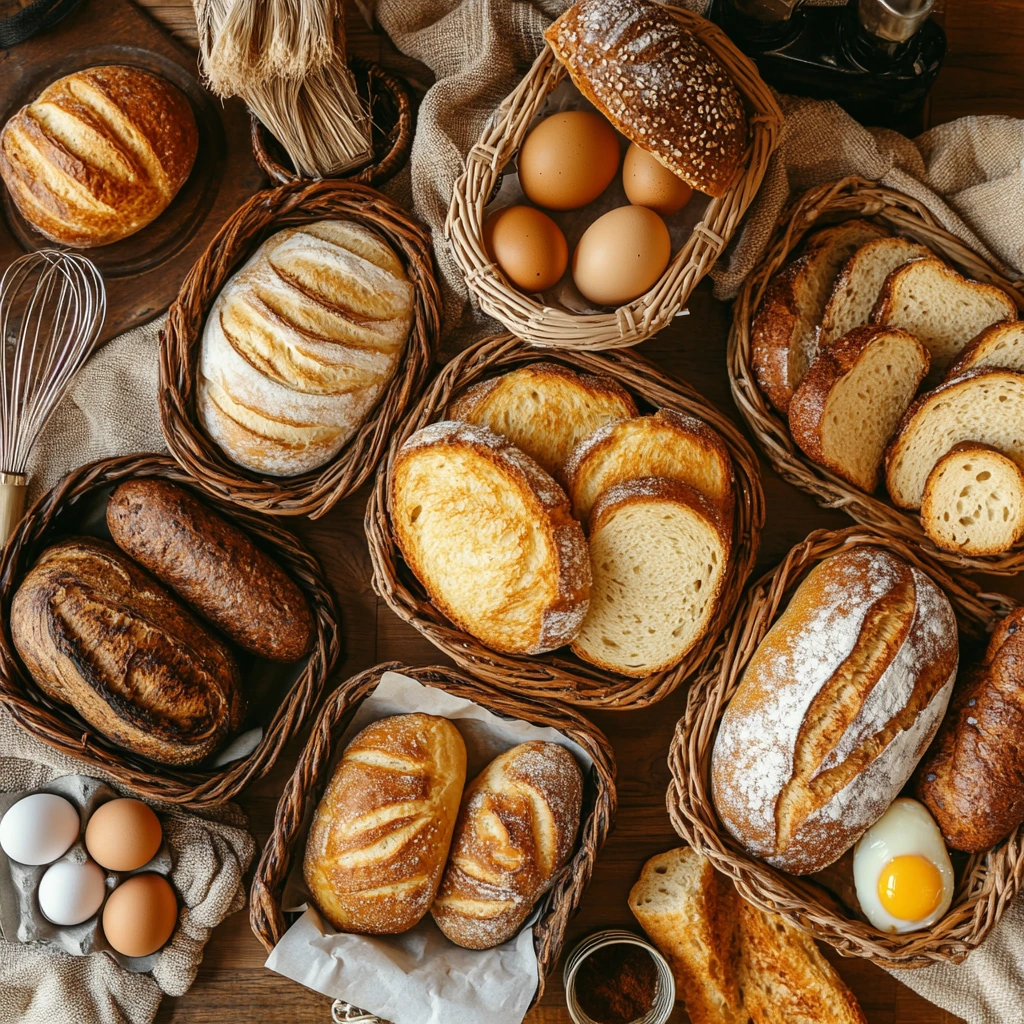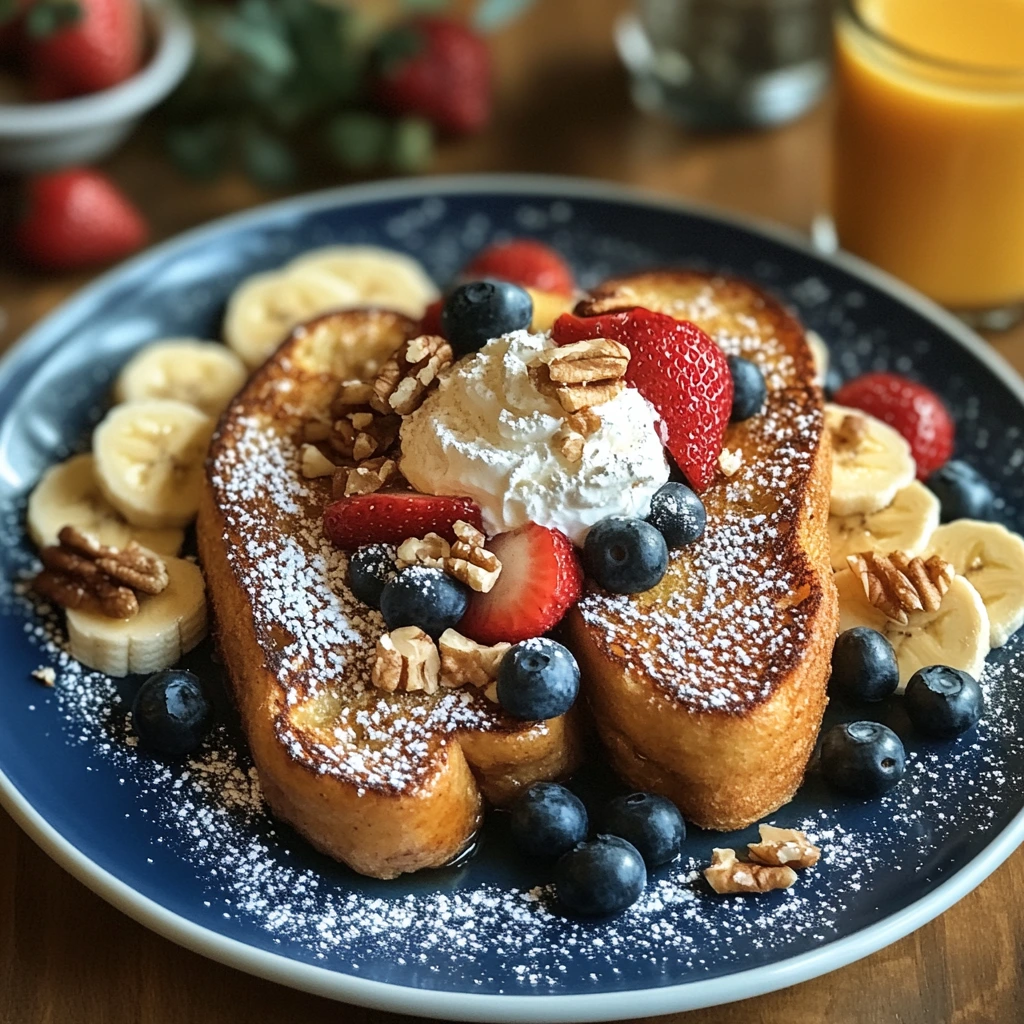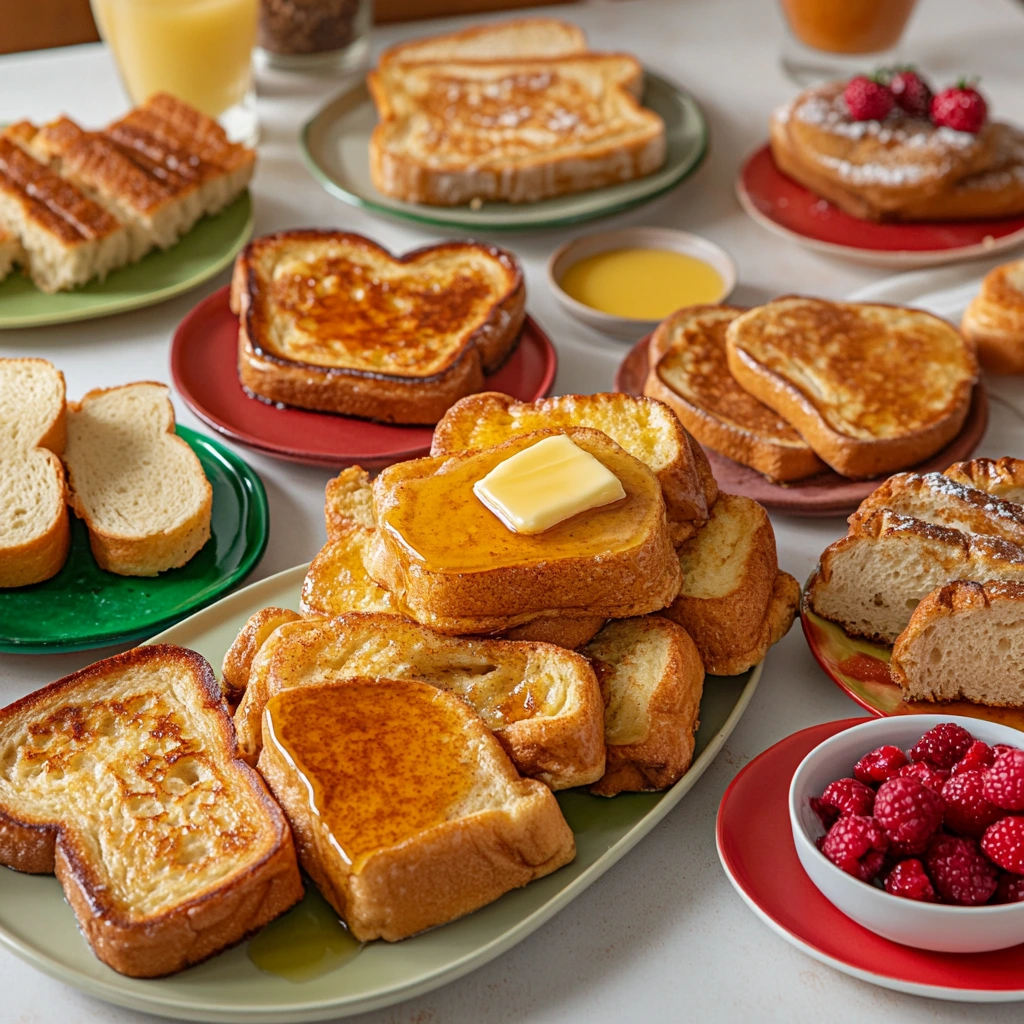What is the Best Bread for French Toast?
The best bread for French toast depends on your preferred texture and flavor. Classic choices like brioche and challah deliver rich, eggy, and slightly sweet profiles that absorb custard beautifully. If you enjoy a tangy flavor, sourdough provides a firm structure and bold taste. For a rustic approach, thick slices of baguette work well, while Texas toast offers a budget-friendly option with a fluffy texture.
To achieve the best results, use slightly stale bread. It absorbs custard more effectively than fresh bread. Slicing bread about ¾ to 1 inch thick ensures a perfect balance between crispness and softness. Choosing the right bread can transform French toast into a delightful and personalized dish.
Table of Contents
1. The Art of French Toast: A Brief History
French toast, known as pain perdu (“lost bread“), began as a way to use up stale bread. In ancient Rome, cooks soaked stale bread in milk and eggs before frying it. Medieval Europeans popularized this practice, adding honey or sugar for sweetness. French cooks elevated the dish into a breakfast staple, while variations like Germany’s Arme Ritter and India’s spiced recipes reflect its global influence.
With its adaptability, French toast showcases how simple ingredients can create a lasting culinary tradition.
2. Importance of Choosing the Right Bread for French Toast
The bread you choose is key to making great French toast. It affects the texture, flavor, and overall quality of the dish. Good bread soaks up the custard without getting too soggy and cooks up with a crispy outside and soft inside. The flavor of the bread also makes a big difference, working with sweet or savory toppings to create a delicious result.
1. Texture and Absorption: Key Qualities of Good Bread
For French toast, the bread needs to be firm enough to soak up the custard but soft enough to stay tender when cooked. Day-old bread works better than fresh because it absorbs the mixture without falling apart. The slices should be about ¾ to 1 inch thick so the toast has a crispy crust and a soft center. With the right bread, you can get that perfect balance of texture.
2. Balancing Flavor Profiles
The flavor of the bread should match your toppings. Sweet, buttery breads like brioche or challah are perfect for syrup and fruit. Tangy sourdough adds an interesting twist, especially with savory options. Neutral breads like Texas toast or baguettes are versatile and work well with any flavor. Choosing the right bread makes every bite more enjoyable.
3. Bread Options to Consider
French toast can be made with many types of bread, but some stand out for their flavor and texture. Here are a few great options to try.

1. Brioche
Brioche is a popular choice for French toast because of its rich, buttery flavor and soft texture. It soaks up the custard beautifully, creating a creamy interior with a golden crust. The slightly sweet taste of brioche pairs perfectly with toppings like syrup, fruit, or powdered sugar, making it a classic for indulgent breakfasts.
2. Challah
Challah is another excellent option, similar to brioche but less sweet. Its soft, fluffy texture and egg-rich dough give it the ability to absorb custard without falling apart. Challah is perfect for French toast recipes that include a mix of sweet and savory flavors, offering a satisfying balance.
3. Sourdough
For a unique twist, sourdough bread brings a tangy flavor to French toast. Its firm texture holds up well to soaking, and the subtle sourness contrasts nicely with sweet toppings like honey or jam. Sourdough is also a great choice for savory French toast dishes.
4. White Sandwich Bread
White sandwich bread is a simple and affordable choice for French toast. Its neutral flavor makes it a blank canvas for any topping, and its soft texture becomes wonderfully fluffy when cooked. Look for thicker slices to ensure the bread doesn’t fall apart while soaking.
5. Artisan Breads
Artisan breads, such as rustic baguettes or ciabatta, create a hearty and textured French toast. Their dense crumb and crusty exterior work well for thicker slices, resulting in a chewy interior and crispy edges. These breads are ideal for rustic or savory-style French toast recipes.
4. Comparing Fresh vs. Day-Old Bread
The freshness of your bread plays an important role in making French toast. While fresh bread can be used, many chefs and home cooks prefer day-old bread for the best results. Here’s why, along with tips for using fresh bread when necessary.
Why Day-Old Bread is Often Preferred
Day-old bread is slightly dry, which helps it absorb the custard mixture without becoming too soggy. Its firmer texture ensures that it holds together during soaking and frying, resulting in French toast with a crispy exterior and tender center. Additionally, using day-old bread is a great way to reduce food waste while creating a delicious dish.
Techniques for Using Fresh Bread
If fresh bread is your only option, you can still make excellent French toast with a few tricks. Try lightly toasting the bread slices to remove some moisture, or leave them out for 15–20 minutes to dry slightly before soaking. These methods help fresh bread mimic the texture of day-old bread, ensuring it absorbs custard properly and cooks to perfection.
5. Preparing the Bread for French Toast
Preparing your bread properly is key to achieving the perfect French toast. From slicing thickness to adding flavors, attention to detail can make all the difference.
1. Slicing Thickness
The thickness of your bread slices affects the texture of your French toast. Aim for slices that are about ¾ to 1 inch thick. This size allows the bread to soak up enough custard for a soft, creamy interior while maintaining a crisp, golden-brown exterior during cooking. Thinner slices may become too soggy, while overly thick slices may not cook evenly.
2. Pre-Drying or Toasting the Bread
For the best results, use slightly stale bread. If your bread is fresh, you can dry it out by leaving it uncovered for 15–20 minutes or lightly toasting it in the oven. Drying the bread ensures it absorbs the custard mixture evenly without falling apart, giving you a perfect balance of texture.
3. Infusing Additional Flavors
Enhance your French toast by adding vanilla, cinnamon, or nutmeg to the custard mixture. These flavors infuse the bread as it soaks, creating a warm, aromatic dish. A pinch of each ingredient can elevate the flavor, making your French toast even more delicious.
6. The Perfect Batter for French Toast
The batter is the key to making great French toast. It adds flavor, richness, and the creamy texture that makes this dish special. Here’s how to create the perfect batter for both sweet and savory versions.
1. Ingredients for Richness and Flavor
Start with the basics: eggs and milk (or cream). Eggs help the bread hold together, and milk adds creaminess. For an extra-rich batter, use heavy cream or half-and-half instead of milk.
To boost flavor, add vanilla and a sprinkle of cinnamon or nutmeg. A pinch of salt balances the sweetness, and a little sugar or maple syrup makes it even tastier. For savory French toast, skip the sugar and use spices like pepper or fresh herbs instead.
2. Balancing Sweet and Savory Options
French toast can be sweet or savory, depending on your batter. For a sweet version, include vanilla, cinnamon, and a touch of sugar. Top it with syrup, fruit, or whipped cream. For savory French toast, leave out the sweeteners and add herbs or spices. Serve it with bacon, cheese, or vegetables.
With a few simple adjustments, you can make a batter that suits any flavor and ensures delicious results every time.
7. Cooking Techniques for Optimal Results
Cooking French toast requires the right techniques to achieve a golden crust and a creamy center. Paying attention to heat settings, frying fats, and cooking methods ensures your French toast turns out perfect every time.
1. Ideal Heat Settings
Cook French toast over medium-low to medium heat. Low heat allows the custard to cook through without burning the outside, while medium heat helps achieve a golden crust. Avoid high heat, as it can scorch the surface before the center cooks. A consistent heat setting ensures even cooking and prevents sogginess or undercooked spots.
2. Butter vs. Oil for Frying
Both butter and oil have their pros and cons. Butter adds a rich flavor and helps create a beautifully browned crust, but it can burn quickly. If you use butter, keep the heat low and watch closely. Oil, such as vegetable or canola oil, has a higher smoke point and is less likely to burn. For the best of both worlds, use a combination of butter and oil. The oil prevents burning while the butter adds flavor.
3. Achieving the Perfect Golden Crust
To get that perfect crust, ensure your bread slices are fully soaked in the custard without becoming too wet. Place the soaked bread into a preheated pan with your butter or oil mixture. Cook each side for 2–3 minutes until golden brown. Don’t overcrowd the pan, as this can lower the heat and result in uneven cooking. For an extra crisp crust, try dusting the bread lightly with sugar before frying.
With these tips, your French toast will have a beautiful golden crust, a soft interior, and incredible flavor.
8. Traditional Syrup and Butter
Classic toppings like maple syrup and butter are timeless for a reason. The sweet, rich syrup pairs perfectly with the crispy, golden French toast, while a pat of melted butter adds creaminess and enhances the flavor. These simple additions create a comforting and satisfying breakfast.

1. Fresh Fruits and Compotes
Fresh fruits such as berries, bananas, or sliced apples add a refreshing twist to French toast. For something more indulgent, use fruit compotes like blueberry or strawberry, which offer sweetness and a burst of flavor. These toppings also add a pop of color, making your dish look as good as it tastes.
2. Creative Additions
Get creative with toppings like whipped cream, chocolate drizzle, or even a sprinkle of powdered sugar. For extra crunch, add nuts or granola. These additions take your French toast to the next level, making it a fun and customizable treat.
3. Storing and Reheating French Toast
If you have leftover French toast, proper storage and reheating techniques will keep it delicious and fresh.
3. Best Practices for Refrigeration and Freezing
For short-term storage, place cooled French toast in an airtight container and refrigerate for up to 3 days. For longer storage, freeze individual slices by layering them with parchment paper in a freezer-safe bag. This prevents sticking and makes reheating easier.
4. Reheating Without Compromising Texture
To reheat, use an oven or toaster oven at 350°F (175°C) for 5–10 minutes. This keeps the toast crisp while warming it evenly. Avoid microwaving, as it can make the toast soggy. For frozen slices, thaw in the fridge overnight or heat directly from frozen using the same method for the best results.
9. FAQs About Choosing the Best Bread for French Toast
Can gluten-free bread be used for French toast?
Yes, gluten-free bread works for French toast if it has a firm texture. A great option might be experimenting with recipes like The Perfect Croissant French Toast to explore texture variations while keeping it gluten-free.
Is sourdough too tangy for traditional French toast?
Sourdough’s tangy flavor may not be for everyone but pairs wonderfully with savory toppings. For sweet versions, consider blending it with toppings suggested in How to Make Perfect Croissant French Toast for balance.
What’s the ideal thickness for French toast bread?
Bread slices about ¾ to 1 inch thick are ideal for a perfect blend of crispy crust and creamy interior.
Should I always use stale bread for French toast?
Stale bread absorbs custard better, but fresh bread can be pre-dried.
Can sweet breads like cinnamon raisin be used?
Absolutely! Sweet breads like cinnamon raisin enhance the dish’s flavor.
Are there vegan options for French toast batter?
Yes, vegan batters can use plant-based milk and flaxseed or chia as egg substitutes.

